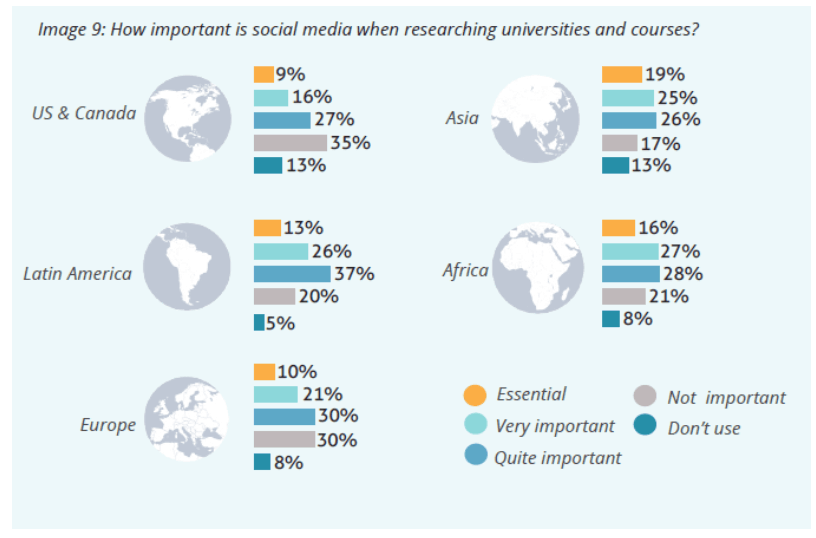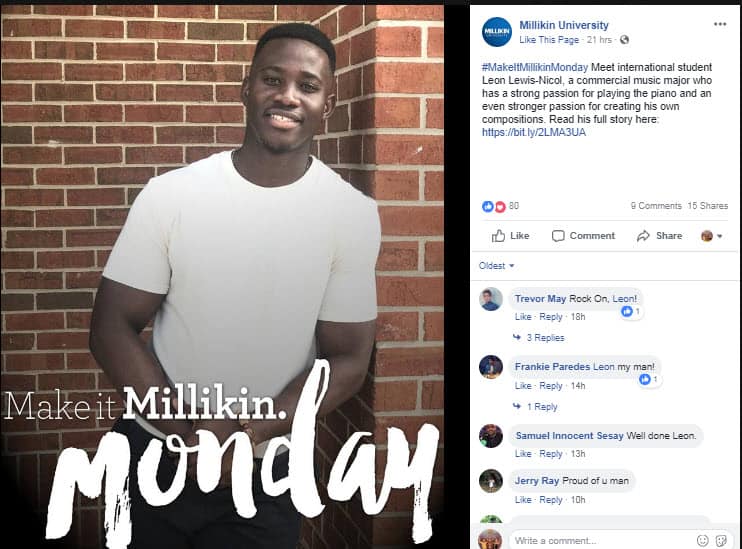
As valuable a tool as social media can be for student recruitment, catering to all of your target audiences on sites like Facebook, Instagram, and Twitter can sometimes be easier said than done, particularly for schools looking to attract international applicants.
Language barriers, cultural variances, and even time zone differences can all make it more challenging to ensure that your social posts are visible, relevant, and engaging for students around the world.
As a result, schools have to think strategically in order to cultivate a more international social media presence. Here’s how to get started.
Understanding Social Media in Different International Student Recruitment Markets
The first step to developing a more internationalized social media strategy is to think carefully about just how important social is in your target markets. While it’s common knowledge that many prospective international applicants will use your school’s social media channels to aid their decision-making process, the level of importance it carries can differ greatly depending on where they are based.
This snapshot from the QS Global Online Trends Report shows how students around the world rate the importance of social media when researching schools:

Perhaps surprisingly, students in Europe, the US and Canada are less likely to consider social media as an important research tool, whereas it is far more highly regarded in Asia, Latin America, and Africa. Schools can use information like this to determine just how much investment to put into social when recruiting international students.
Another important element to consider is which channels students in your target markets are using. Schools targeting China will no doubt be aware that the country’s strict internet controls mean that many major global social media sites are not available in the country, and that they need to establish a presence on domestic platforms like WeChat and Sina Weibo.
Other countries also have their own domestically popular social networks, like Naver Café in South Korea and VK in Russia. You will also find that other sites are either more or less popular elsewhere than they are in your home market. For example, while Snapchat has become an increasingly popular tool among schools for social engagement, it is far more popular in North America and Europe than it is in the rest of the world:

North American and European schools who may have had success using Snapchat to target students may thus find that the social network doesn’t have quite the same pull in other countries. Applying a one-size-fits-all strategy to your domestic and international social media efforts will probably result in diminishing returns, and should be avoided.
Scheduling and Language Concerns When Targeting International Students on Social Media
Scheduling posts at the optimum times to reach international students could be important to attracting engagement. Due to time differences across the world, your regular posts could be going out in the middle of the night in your target market, limiting their potential for reach and engagement. Using a scheduling tool like Hootsuite could be a way to ensure that any posts that go live will have a good chance of being seen by your audience immediately.
Having said that, it’s wise not to overestimate the importance of post scheduling. The shift towards algorithmic rather than chronological feeds on platforms like Instagram, Twitter and Facebook over the past number of years has meant that quality, authority, and engagement are far more pertinent than recency, and your posts will likely still be seen by prospects if they demonstrate enough serious interest in your school.
Another important aspect to consider when creating social media marketing campaigns for international student recruitment is language. If you have a very specific target market, or are operating on a region-specific site like WeChat, it may be best to use the language of your prospective students in order to increase engagement.
Example: The University of Michigan posts in Chinese on Sina Weibo.

However, as a general rule, it is acceptable to post in your own language when communicating to international students from your main social accounts. Sites like Facebook are now automatically translating posts into the language of their users, too, making it easier for them to understand and connect with them. Nonetheless, it’s important to be mindful of potential language barriers. Try to keep your posts as simple as possible, avoiding overcomplicated words and emphasizing visual content to aid understanding.
Example: Mindful of its audience, ESL pathway program provider CultureWorks uses simple and visual posts to connect with students, sharing tips to improve their skills.

Developing Social Media Content that Speaks to International Student Personas
Creating well-researched, targeted international student personas will help to drive all of your school’s initiatives tailored to this audience, and this is especially true when it comes to social media. Research in Hobsons 2017 International Student Survey found that the majority of visits from international students to social media pages come before an inquiry is made:

Source: International Student Survey
This suggests that prospective applicants use social media to gain an insider’s look at life at your school, making it an especially valuable tool during the awareness stage of the enrollment funnel. International students will be looking to see how welcoming an environment you offer, and for signs that your institutional culture is a match for their specific needs and goals.
While these can differ greatly depending on your target market, these are some common things you can look out for. For instance, it is often the case that prospective international students are more concerned about academics and career outcomes than other aspects of college life like social opportunities, which might be more of a selling point for domestic applicants. Thus, schools looking to specifically make inroads into international markets would be advised to emphasize the educational opportunities available by posting about things like student success stories, notable facilities or instructors, and cutting edge academic research or programs.
Example: This link to a post discussing the success story of a Ghanaian student earned Goodwin College in Connecticut almost 3,000 likes on Facebook.

However, it is important not to assume that this is all international students care about. One area you may want to use your social media channels to highlight is your location. Whereas domestic students will find it easier to visit your school and see your campus, facilities, and home city in the flesh, many international students will not have that luxury prior to enrollment.
Showcasing your surroundings with eye-catching images and videos, posting about cultural attractions and amenities in your city, and even featuring online campus tours through video and livestreaming platforms can all be good ways to give students the next best thing to being there.
Example: The University of Aberdeen offered this campus tour on Facebook Live recently, attracting over 2,000 views.

Another aspect of campus life which tends to be important to international students is the level of safety and inclusiveness they can expect. Recent global events have left international applicants feeling more apprehensive about applying to schools in top study destinations like the USA and the UK. Schools in these countries need to make more of an effort to ensure they feel welcome, and know that their culture and beliefs will be respected and tolerated within your community.
One great way to do this may be to participate in some of the wider social media initiatives which have sprung up over the past few years to promote inclusion within the education sector, such as #YouAreWelcomeHere, #WeAreInternational and #LondonisOpen. These hashtag campaigns have been seen to be very effective in improving international audience’s perceptions of studying in other countries.
It might also be helpful to showcase the diversity of your current student body. Providing a platform to student societies, events, and initiatives which provide an outlet for or celebrate your target audience’s culture will show that your school is committed to giving its international contingent a voice and a place within your community.
Example: This post on Instagram from Columbia College marked International Friendship Day with a photo of the university’s diverse student body. Capitalizing on widely used hashtags that promote inclusion and tolerance will help foster positive perceptions among your audience.

In addition, featuring posts celebrating some of your current international students can be a very effective way to engage new prospects. Introducing them to someone from their background who shares their culture, needs, and goals will make it that much easier for them to picture themselves growing and thriving at your school.
Example: This post from Millikin University in Illinois features an international student from Sierra Leone.

Another particularly important aspect of using social media to recruit international students is direct messaging. The use of platforms like WhatsApp, Messenger, and China’s WeChat tends to be much more widespread in certain countries, and it is possible that international students will be more likely to make inquiries about your school through these channels than domestic prospects. Monitoring and responding to these inquiries quickly could be very important to holding their attention and encouraging them to take the next step.
Boosting Posts and Using Advertising to Recruit International Students
The algorithm changes that sites like Facebook, Instagram, and Twitter have introduced over the past number of years have severely limited the organic reach of institutions, particularly outside of their immediate local markets. As a result, paid initiatives have become essential to any effective social media marketing strategy.
This isn’t necessarily a bad thing. A geotargeted paid campaign can help to enhance your visibility specifically within your priority markets. For instance, if you are creating certain posts with prospective international students from a certain country in mind, you can boost those posts within that location to ensure they are seen by prospects in that market.
Example: Browns English Language School in Australia posted this interview with a Brazilian student. Boosting a post like this in Brazil would be a great way to engage more prospective students from the country.

Social ads can also be extremely beneficial. For instance, awareness based campaigns developed with the goal of gaining likes or followers on your school’s social media pages are ideal for increasing your overall visibility when entering a new international market. Lead generation ads can also be very effective, and can be developed in the language of your targeted students. However, it is important in that case to also create customized landing pages in that language too, as leads who click on your ads are likely to expect it.
All of these efforts can help to increase the overall reach and engagement of your social media campaigns in different countries and regions, but it is important to properly measure their effectiveness. Analyzing your traffic through Facebook Insights, Twitter Analytics and other tools will give you a sense of how much engagement your are generating, the types of interactions you are attracting, and where it is coming from. This data can serve as the basis for your ongoing efforts, ensuring your social media initiatives adapt and respond to the changing needs of an increasingly diverse online audience.







